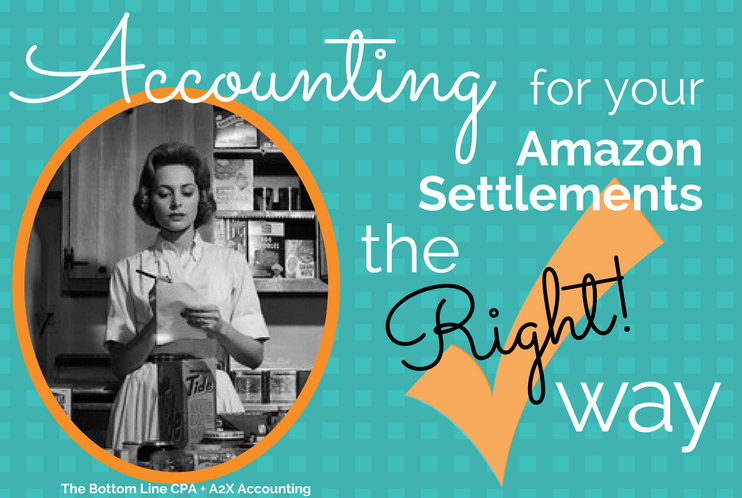
Our pals at A2X are changing the game when it comes to automated accounting for Amazon sales and fees. We reached out to them to ask about an area that befuddles many an online retailer: cash accounting vs. accrual-based. As you'll see, this can have a BIG impact on your business' financial reporting…which means another BIG impact when tax season rolls around.
Keep reading for the A2X team's insight on how to make life and profit-planning simpler and sweeter!
Amazon typically pays marketplace sellers every two weeks. When this deposit arrives into your bank account, you need to account for it and how you do this can have a big impact on your business’ financial reporting.
In this blog post, we wanted to cover some of the mistakes Amazon sellers make when accounting for their Amazon settlements, how these mistakes affect their financial reports and how using A2X can make it easy to account for the settlements correctly.
[Tweet “Amazon sellers! Do you use cash- or accrual-based accounting…and why?”]Cash accounting for your Amazon settlement
In accounting there are two methods for recognizing revenue and expense: cash and accrual. If you record the deposit Amazon pays in your bank account as ‘Amazon sales’ on the date it arrives in your bank account, this is is using a cash accounting method.
What is wrong with cash accounting for Amazon settlements?
For sellers who are just getting started with Amazon cash accounting is an easy, fast way to account for your sales. It’s tempting to use this technique, but we advise sellers against it. This approach has a number of problems.
Firstly, it ignores the timing of the transactions.
Timing the transactions is crucial for business reporting based on periods, and comparing those. For example if you recorded $10,000 deposit from Amazon on the 4th of May, this deposit could reflect 2 weeks worth of sales and fees. That would mean that 4 days of the settlement are from May, and 10 days are from April. If you record all of the amount in May, then 10 days of April are missing, and May has an extra 10 days. Now if you try to compare April and May to see if your business is growing, you will have no easy way to correct the imbalance. Likewise if you tried to compare May this year with May last year, you would face similar difficulties as the number of days sales captured in May this year and last year will be different making comparison of the sales unreliable.
Secondly, this cash-based approach loses valuable information about the different sales and fees Amazon charged that are removed before the deposit is paid.
Understanding and accounting for the various types of fees and sales amounts in the settlement is important to understand and accurately report on profitability and expense ratios within your business. For example if you do not account for Amazon FBA storage separately, you will not know what percentage of your sales revenue is being spent on storage, or whether those storage costs are increasing each month, or decreasing.
[Tweet “How cash-based accounting could be getting in the way of your Amazon biz profitability: “]How to account for your Amazon settlements the right way?
By using A2X to account for your Amazon settlements, you can correct both of these problems and ensure more accurate business financial records & reports. A2X does two things to address the problems we have highlighted:
- A2X will split the sales, fees and charges in the Amazon settlement data based on the month in which they happened. So in the example scenario we used above, A2X will create a consolidated invoice for the April period, covering 10 days and a second invoice for the May period covering 4 days. The net total of these invoices will match and reconcile to the deposit from Amazon that arrives early in May. So you can be confident you have accounted for every dollar that Amazon has paid you.
- A2X will split and consolidate the various sales, revenue, fees and expense transactions in the Amazon settlement. These separate line items are then included on each A2X invoice and can be accounted for individually. For example if your $10,000 deposit was actually $15,000 in sales, and $5,000 in various fees and charges, these will be captured and can be accounted for as such.

A2X is constantly checking your Amazon account for new settlements. As soon as a settlement is detected, it is imported to A2X, processed and the data is available to send to your accounting system (such as Xero!).
Marilyn and the team at The Bottom Line CPA say:
“A2X is the hassle-free cure to putting the financial facts our clients can trust for Amazon sales and fees on the books every time they receive a deposit”.
In conclusion, there are several problems with a purely cash-based approach to accounting for your Amazon settlements and A2X helps to address these problems and ensure more accurate, timely business financial reporting.
Ready to get your financial foundation in place with Xero and A2X? Connect with the team at The Bottom Line CPA for exclusive Xero and A2X offers.
You can also sign up for a free trial of A2X's cloud-based transaction feed service by clicking here!
